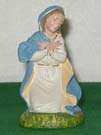The Nativity
|
My interest in completing the set has developed into an interest in collecting vintage nativity pieces, especially the 5" size. This website began as a checklist for myself of what pieces I have in my collection but has developed into something I'd like to share with you. It can help you in your collecting by seeing a side by side comparison of the different pieces from different countries. Many look very much alike, but when viewed side-by-side you can see the differences. A Brief History of Nativity DisplaysAs far back as the second century Christians have celebrated the birth of Christ in Bethlehem. In 326 AD, the converted Emperor Constantine had the pagan temple destroyed that was built over the birth place of Christ. He and his mother, St. Helena, then had the Basilica of the Nativity built at the site. Pope Sixtus III had a small chapel built in the Church of Santa Maria Maggiore that had a manager scene. In the 13th century the first free standing figures were sculpted by Arnolfo di Cambio for the chapel. It was also at this time, when nativity dramas were banned by the Pope because they were getting out of hand, that Francis of Assisi made a special request to Pope Honorius III for permission to celebrate the birth of Christ in his own way. Shortly before Christmas of 1223 Francis arranged with a landowner in the Italian village of Greccio to prepare a place for a special cermony. Velita set up in a cave a manger filled with hay. An ox and donkey were stabled and invitations were sent to all in the area. Francis, with the help of others, celebrated Christmas mass with the manger as the alter. There were no shepherds, kings or angels being portrayed. It was quite simple, but made an everlasting impression on how we were to venerate the birth of Christ. By the 17th century German artisans were carving figures of the nativity from native woods and arranging creche scenes in churches, homes, and market places. In Italy the materials used were based on geographic location. The Sicilian presepe used materials such as coral, ivory, mother-of-pearl, and alabaster. The Roman presepe reproduced the landscape of the countryside with olive trees, pine trees, and even the ancient aqueducts. In Napoli the nativity scene became quite an artistic endeavor. The scenes became very elaborate and dramatic, full of minor characters that had little to do with the actual biblical story. The pieces were made of wood or terracotta and sculpted by leading artist. These figures were not intended for churches, but rather the homes of wealthy patrons. The idea of creating a nativity scene came to America with the migration of the Moravian Protestants in the 18th century. In 1741 the town of Bethlehem, Pennsylvania was settled and it is there that the tradition of building elaborate putz scenes began and continues to this day. The word 'putz' comes from the German verb 'putzen', meaning 'to arrange or decorate'. The figures are often hand carved and set amongst a landscape of mountains and valleys, driftwood, colorful rocks, and village houses. The story of our Lord's nativity comes from the gospels of Matthew and Luke. Joseph and Mary journeyed to Bethlehem to take part in the census ordered by Caesar Augustus. There they found no shelter, except for a stable. The Christ child was born in a manager and wrapped in a blanket. The angels of the Lord appeared to shepherds watching their flocks and singing the praises of the Lord. A bright star appeared in the sky that attracted three wise Kings who followed it to the birthplace of Jesus.
| |||||||||||||||||
 As long as I can remember celebrating Christmas I remember a nativity set under the Christmas tree.
My grandparents had a set of mixed pieces from Germany and Japan. They were made of paper marche or
composition and the taller figures stood about 5 inches. The baby Jesus in his manger was made of
chalk or plaster and was a heavy piece. I always liked to gaze at the pieces and image I was at the
nativity of Christ. I still have those pieces and I treasure them (see photo on left).
As long as I can remember celebrating Christmas I remember a nativity set under the Christmas tree.
My grandparents had a set of mixed pieces from Germany and Japan. They were made of paper marche or
composition and the taller figures stood about 5 inches. The baby Jesus in his manger was made of
chalk or plaster and was a heavy piece. I always liked to gaze at the pieces and image I was at the
nativity of Christ. I still have those pieces and I treasure them (see photo on left).









